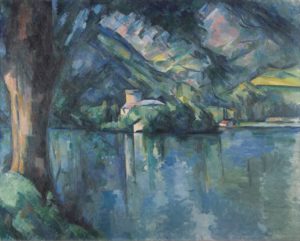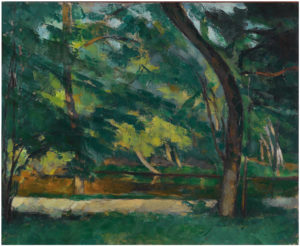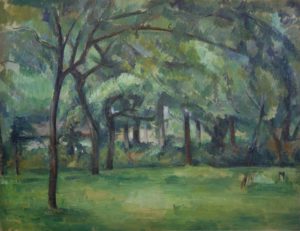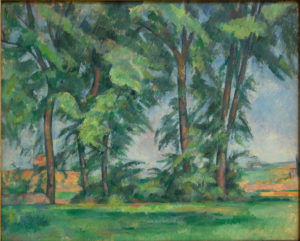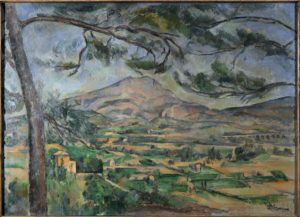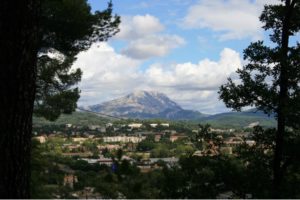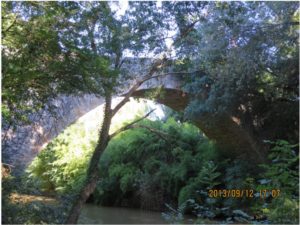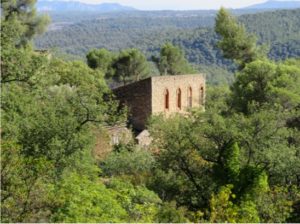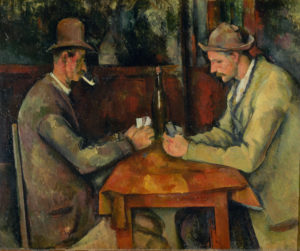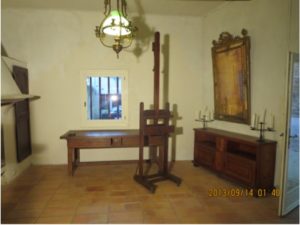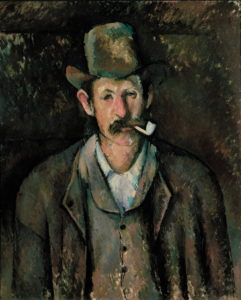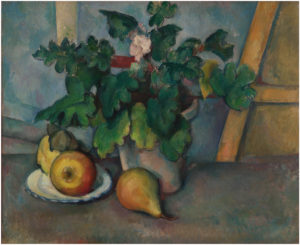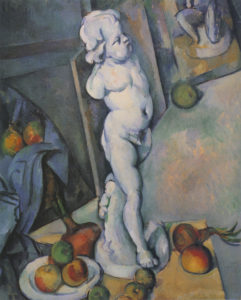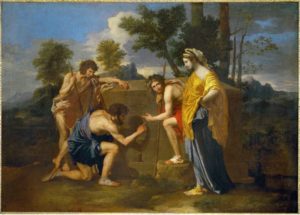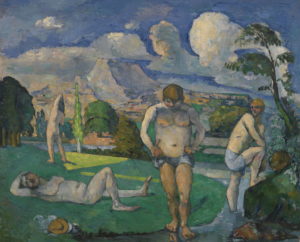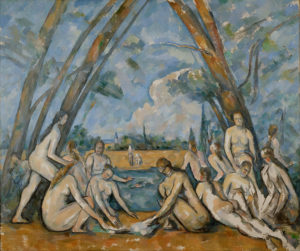Cezanne’s Arcadia—Provence
Takanori Nagaï, Associate Professor, Kyoto Institute of Technology
*This text is the English version of the article in Japanese in the following exhibition catalogue;
Takanori NAGAÏ, Sezan’nu no arukadia-purovansu(in Japanese),Masterpieces of Impressionism:The Courtauld Collection (Exhibition_flier), Tokyo Metropolitan Art Museum, September 10-December 15, 2019, Published by The Asahi Shimbun/NHK/NHK Promotions Inc., 2019-2020, pp.68-73.
Cezanne’s Parisian dream
Born and raised in the ancient city of Aix-en-Provence, in the South of France, Paul Cezanne grew bored with provincial life and weary of being tied down by his family. He dreamt of becoming a painter and ached for the freedom to taste fresh experiences; in imagining a life of discovery and encounter, he yearned for Paris. Encouraged by his boyhood friend Émile Zola (1840–1902), the future naturalist novelist who was already working in the city as a critic by this time, Cezanne set off for Paris in 1861, at the age of 22. It proved to be a false start: he soon became downhearted, returned home and took a job at his father’s bank. Unwilling to abandon his dream, however, and after finally gaining his father’s approval, he resumed his Parisian adventure and enrolled in the art school Académie Suisse. Twice he sat the entrance exam for the École des Beaux-Arts, and twice he failed. Responding to the diverse influences of the contemporary art scene—the fresh appeal of the passionate paintings of Eugène Delacroix (1798–1863); the sensation stirred by the works of the provocative Gustave Courbet (1819–1877); and the avant-garde movement fomented by Édouard Manet (1832–1883)—Cezanne began to produce paintings that were gloomy and ominous, extreme and grotesque. He repeatedly submitted them to the state-sponsored Salon, but each time they were rejected. He came to be counted among the most radical of artists, in open revolt against the aesthetic values promoted by the Academy and painters at the Salon, and a favourite target for furious censure by Establishment critics. The career path his father may have anticipated—student of the École des Beaux-Arts, doyen of the Salon, member of the Academy and, ultimately, a professor of the Beaux-Arts showered with honours—retained not one shred of appeal for the son. He chose instead to become a bohemian painter, a maverick of the art world.
Pontoise today is just an hour’s journey from the capital. There, working outdoors alongside Camille Pissarro (1830–1903), a colleague from the Académie Suisse, Cezanne acquired the Impressionist aesthetic and techniques whereby sensations received in the act of observing nature were translated directly onto canvas, in contrast to painting that seeks to evoke the artist’s inner life. In the 1860s and 1870s, the Industrial Revolution and the vast urban renewal that accompanied it transformed Paris, both the city’s appearance and the manners and habits of its citizens. Impressionist artists, including Manet, Claude Monet (1840–1926), Pierre-Auguste Renoir (1841–1919), Edgar Degas (1834–1917) and Gustave Caillebotte (1848–1894) avidly addressed themselves to the symbols of the age : buildings made of iron and glass, iron-clad steam locomotives and other innovations ; bustling, lively streets full of people rushing hither and thither ; and scenes of relaxation at theatres, dance halls, skating rinks, circuses, yachting and boating venues, cafes and World’s Fairs. For Cezanne, the country lad who grew up romping in streams, fishing, climbing mountains and wandering through fields with his friends, including Zola, modern life and its urban preoccupations must have seemed amazing. Even so, for this particular painter, they were not worthy subjects for his art; he preferred to apply his brush to delineating pristine nature around the rural towns, untouched by modernisation, in Île-de-France. Cezanne’s reaction to the bustle and artificiality of Paris, alive with radical impulses, differed greatly from that of his fellow Impressionists; he carved a unique creative path using contact with nature to stimulate instincts and primitive sensations.
The Paris environment nevertheless played a not insignificant part in the formation of Cezanne’s art. Indeed it was indispensable. Apart from one trip to Switzerland, the painter never left France. He spent his life in a fairly narrow geographic orbit, going back and forth between Provence and Île-de-France, aside from sojourns in Vichy and Talloires (Fig.1, Le Lac d’Annecy).
He travelled more than twenty times between Aix and Paris by steam locomotive, the state-of-art technology of the day, and made long and short stays in Île-de-France. The Musée du Louvre was a favourite haunt of his, from youth to old age: he never stopped learning from the great masters of the past by copying their works. He also frequented the Salon venues and the Musée du Luxembourg to view the Salon selections and the national purchases and visited different galleries to take in private and group shows. At the art-supply shop run by ‘Père’ Tanguy (1825–1894) in the rue Clauzel, by meeting the cutting edge of the avant-garde, he had the opportunity to reflect deeply on his own art. Through observing the perspectives and methods of painters, both past and present, he was able to measure his own originality and carry it forward. Without Paris, Cezanne’s art and thought would not have taken the shape they did [1]Takanori Nagaï, ‘Sezannu no Pari taizai no imi [Significance of Cezanne’s Parisian sojourns]’, NACT News, no. 22 (2012), pp. 2–3..
Rediscovering Provence
While staying in Île-de-France at the end of the 1870s, Cezanne left off the Impressionist method of ‘divided brushstrokes’ used to represent phenomena on canvas and developed a technique of his own invention, ‘constructive brushwork’, seeking to create a rhythmic order on the picture plane. He thus began to pursue a unique, autonomous method of painting (Fig.2, L’Étang des Sœurs, Osny; Fig.3, Ferme Normande, été (Hattenville)).
Around the middle of the 1880s, he rediscovered the landscape of Provence, recognising it offered the motif best suited for obtaining his goal. The gaze of the urban dweller he had acquired in the alien environment of Paris, paradoxically, enabled him to see, with fresh and wonder-filled eyes, a landscape that had seemed commonplace from his boyhood. In the fierce sunlight and piercing dry air of the South of France, the contrast of light and shade is so sharp that things appear as composites of flat surfaces, without the shading that conveys three-dimensional relief, and deeply and intensely coloured. The region’s climate and geography were the creative catalysts when Cezanne set about geometrising and simplifying landscape images. Moreover, responding to the changing colour tones of clusters of tree branches and leaves under the dazzling sunlight, the painter further refined his unique method of ‘modulation’ by juxtaposing strokes of colours of varying brightness and intensity to express massiveness, light and shade, and depth (Fig. 4, Les Grands Arbres au Jas de Bouffan).
Provence supplied Cezanne with an inexhaustible array of motifs that included: the family manor of Jas de Bouffan, outside Aix, and the nearby properties of Bellevue (Fig.5,Fig.6, Montagne Sainte-Victoire with Large Pine)
and Montbriand where his sister lived; the River Arc, his bathing spot with Zola as a child, and the bridge of Les Trois Sautets (fig. 7) ;
the changing faces of Montagne Sainte-Victoire, visible from many parts of Aix; the manor of Château Noir, where he rented a room to store his painting materials in his later years, and the surrounding forest (fig. 8),
as well as the Bibémus quarries, where he rented a small cabin to get away to paint, and the surrounding forest; the studio he built beside the Chemin des Lauves ; and Marseille and the nearby fishing village of L’Estaque, as well as Gardanne, a village located between Aix and Marseille.
Provence not only supplied landscapes, it also fed his portraits and still lifes. At a time when fashionable painters of the Salon were turning their attention to bourgeois Parisians and Parisiennes, Cezanne chose his sitters from among anonymous Provençals, who had nothing to do with authority or political or financial power, and captured their simple, naive qualities [2]Cf. T.J. Clark, ‘Relentless Intimacy’, London Review of Books, vol. 40, No. 2 (25 January 2018), pp. 13–16. (Fig.9, Fig.10, The Card Players; Fig.11,Man with a Pipe).
Similarly, when tackling still lifes, he remained utterly indifferent to luxurious or expensive objects, or anything desirable. He painted the commonplace plaster statues kept in his studio or fruits, plants and flowers that came readily to hand. As an artist, he could extract their deep, rich colours, and his arrangements of objects transformed still lifes into compositions filled with tension (Fig.12, Pot de fleurs et fruits; Fig.13, Nature morte avec l’amour en plâtre).
In his early years, Cezanne had condemned paintings of the Paris Salon for their vanity and ostentation; he now discovered in the simple landscapes, rustic inhabitants and plain objects of Provence the ideal means for realising his unique aesthetic values—his ‘Provençal aesthetic’. [3]Nina Maria Athanassogolou-Kallmyer, Cezanne and Provence: The Painter in His Culture (Chicago; London: The University of Chicago Press, 2003)..
Arcadian Provence
-
The ideal of painting
‘Imagine Poussin entirely redone after nature’, Cezanne used to say, ‘that’s what I mean by classical’ [4]Émile Bernard, ‘Souvenirs sur Paul Cezanne et lettres inédites’, Mercure de France, vol. 69, no. 247 (16 October 1907), p. 627.. He forever harboured a desire to attain the Classicism—the order and equilibrium—of a Nicolas Poussin (1594–1665), albeit in his own way, by giving order to the sensations he received from nature [5]Cf. Richard Shiff, Cezanne and the End of Impressionism: A Study of the Theory, Technique, and Critical Evaluation of Modern Art (Chicago; London: The University of Chicago Press, 1984), pp. 175–86; Richard Kendall, ed., Cezanne and Poussin: A Symposium (Sheffield: Sheffield Academic Press, 1993).. Cezanne made copies of works by Poussin at the Louvre when he was young and an Et in Arcadia ego (Fig. 14) always hung on the wall of his studio.
An effect evident in that work is also observable in Cezanne’s Montagne Sainte-Victoire with Large Pine (Fig. 5), where the pine branches in the foreground and the mountain behind are meshed, compressing the middle ground and giving the composition a dense appearance. Nature in Provence served his painterly ideal well. But his interest in the Classical was not limited to matters of composition; he was also deeply fascinated by the ‘eternal’ quality found in Classical art. In fact, the works he sketched most frequently on his regular visits to the Louvre were Classical sculptures [6]Takanori Nagaï, ‘Sezannu ni okeru “mosha” no imi [Significance of ‘copy’ in Cezanne]’, Bijutsu Forum 21, no. 31 (2015), pp. 114–123..
The geology of Provence had its own ‘eternal’ dimension. One of Cezanne’s childhood friends, Antoine-Fortuné Marion (1846–1900), a student of zoology and geology, went on to become a professor at the University of Marseille and director of the Natural History Museum in Marseille. He once discovered a Neolithic cave with the remains of a prehistoric human settlement. Influenced by his friend, Marion tried his hand at painting, and Cezanne, for his part, took an interest in the ancient rock strata of Provence. During his last years, he probed the Bibémus quarries at the foot of Montagne Saint-Victoire, near Aix, and ventured into the forest of the Château Noir to observe and paint rocks and geological strata [7]Cf. Nina Maria Athanassogolou-Kallmyer, Cezanne and Provence…, pp. 149–231.. Primeval remains and ancient Classical sculptures float free of the transient steam of time. Cezanne transformed figures and landscapes, removing them from time, giving them an autonomous sense of order; in the natural setting of Provence, he apprehended eternity’s immutable face, a thing far from our mutable world, and found inspiration for his ‘autonomous painting’.
-
Paradise Lost
The nature of Provence was an intimate and familiar setting for Cezanne, the source of so many boyhood memories of days spent at play with Zola and friends.
Bathers at rest (Fig. 15), showing young boys relaxing by the water, stemmed from his memories of bathing in the River Arc, outside Aix (Fig. 7).
To paint the scene meant to relive it. Likewise, in later years, while intently painting forest trees and rocky tracts, he was led by an unconscious desire to recapture the enjoyment of his boyhood ramblings and adventures. It is thought that these works represented an attempt to restore the lost paradise of his boyhood or maintain, through the act of painting, his own personal vitality well into old age.
Cezanne devoted a great deal of time to painting scenes with female bathers (Fig. 16).
He dreamt of painting bathing scenes by having women models play in the River Arc where he had once disported himself. But he could also imagine the uproar this would provoke in a provincial area, and the idea was never put into practice. The dream lived on in his imagination and took the form of bathing scenes painted in his later years. For Cezanne—a devout Roman Catholic who faithfully attended Mass—nudes playing among rivers and forests presumably conjured up a lost ‘eternal Eden’ [8]Sotaro Nakai, Kindai geijutsu gairon [Introduction to modern art] (Tokyo: Nishodo Shoten, 1922), p. 183..
The solitary Cezanne
As Cezanne went about trying to represent a lost paradise by painting the natural features of Provence, others were forming various impressions of his personality.
In his later years, he disappeared from Paris art circles and stayed in Aix-en-Provence, far from the capital. He spent his time in Aix absorbed in producing works and, as much as possible, avoided communicating with people and mixing in society. To the artists Francis Jourdain (1876–1958) [9]Francis Jourdain, ‘À propos d’un peintre difficile : Cezanne’, Arts de France, no. 5 (1946), p. 8. (Reprinted in Michael Doran, ed., Conversation avec Cezanne (Paris: Macula, 1st ed., 1978; rev. 10th ed., 2011), p. 148.) , R.P. Rivière and Jacques Félix Schnerb (1879–1915), he seemed a ‘solitary’ presence [10]R. P. Rivière and J. F. Schnerb, ‘L’Atelier de Cezanne’, La Grande Revue, vol. 46 (25 December 1907), p. 812. ; to the art critic Joachim Gasquet (1873-1921), he was a ‘saint’ [11]Joachim Gasquet, Cezanne, (Paris: Les Éditions Bernheim-Jeune, 1921; new ed., 1926), p. 127.; to Maurice Denis (1870–1943), he was a figure of ‘myth’ [12]Maurice Denis, ‘Cezanne’, L’Occident, vol. 12, no. 70 (September 1907), p. 119. ; and to the Japanese poet Kotaro Takamura (1883-1956), he was the ‘sage of Aix’ [13]Kotaro Takamura, Inshoshugi no shiso to geijutu [Thought and art of Impressionism] (Tokyo: Tengendo Shobo, 1915), p. 10..
Paul Gauguin (1848–1903), who paid attention to Cezanne before any of these, had already dubbed him ‘the misunderstood’:
In short, you find in graphology the traits of candid men and other [traits] of liars. Why then should lines and colours not reveal the more or less grand character of the artist? Look at Cezanne, the misunderstood, with the essentially mystical nature of the Orient (with a face like an elder of the Levant): he is partial to forms imbued with mystery and heavy tranquillity, as a man lying down to dream, and his colour is grave like the character of an Oriental. A man of the South, he spends whole days on the mountaintop reading Virgil and gazing at the sky, so his horizons are elevated, his blues deeply intense and his reds stunningly vibrant. Just as Virgil has multiple meanings, interpretable at will, so the literature of [Cezanne’s] paintings has a parabolic meaning with dual purposes; his backgrounds are as imaginative as they are real. To summarise, when you see a picture by him, you exclaim, ‘How strange, this is crazy!’ His is an idiosyncratic, indefinable ‘handwriting’; and the same goes for his drawings [14]Paul Gauguin, ‘Letter to Émile Schuffenecker, 14 January 1885’, inCorrespondance de Paul Gauguin, ed. Victor Merlhès (Paris: Fondation Singer-Polignac, 1984), p. 88..
By focusing on the forms and colours in Cezanne’s paintings, Gauguin interpreted the artist’s personality and likened him to a mystic from the East, dreamily enjoying life, contemplating nature in the South of France, far from the mundane world. The image evokes the noble, unworldly sages of Japanese Nanga paintings passing their secluded but comfortable lives deep in the mountains [15]Takanori Nagaï, ‘Sho no bigaku to Furansu kindai bijutsu [Aesthetics of calligraphy and French modern art]’, Bijutsu Forum 21, no. 39, (June 2019), pp. 57–64..
The Cezanne who put his heart and soul into painting in Provence, his timeless Arcadia of memory and life—albeit an image that has come down through the generations like a time-honoured legend, it remains, nevertheless, as vivid as ever. Different from his persona as the pioneer of modern painting, ‘father of modern art’, it presents us another face of an artist who never ceases to fascinate.
(Translated by So Ota and Walter Hamilton)
Figures
Fig.1《Le Lac d’Annecy》FWN311,1896, Oil on canvas,65x81cm, The Courtauld Gallery, London
Fig.2《L’Étang des Sœurs à Osny, près de Pontoise》FWN106,1877,Oil on canvas,60×73.5cm, The Courtauld Gallery, London
Fig.3 《Ferme Normande, été (Hattenville)》FWN183,1882,Oil on canvas,49.5×66.0cm,The Courtauld Gallery, London
Fig.4《Les grandes arbres au Jas de Bouffan》FWN213,1885-87,Oil on canvas,64.7×79.5cm, The Courtauld Gallery, London
Fig.5《La Montagne Sainte-Victoire au grand pin》FWN235,1887,Oil on canvas,66x90cm, The Courtauld Gallery, London
Fig.6《La Montagne Sainte-Victoire》Photo©Takanori NAGAÏ 2014
Fig.7《Le Pont des Trois Sautes sus la rivière d’Arc》Photo ©Takanori NAGAÏ 2014
Fig.8《Château Noir》Photo ©Takanori NAGAÏ 2016
Fig.9《Les Joueurs de cartes》FWN686,1891-6,Oil on canvas,60x73cm, The Courtauld Gallery, London
Fig.10《La pièce dans une ferme où Cézanne exécuta <Les Joueurs de cartes>》Photo ©Takanori NAGAÏ 2014
Fig.11《L’Homme à la pippe》FNW504,1891-6,Oil on canvas,73x60cm, The Courtauld Gallery, London
Fig.12《Pot de primevères et fruits》FWN812,1888-90,Oil on canvas,45x54cm,The Courtauld Gallery, London
Fig.13《Nature morte avec l’Amour en plâtre》FWN692,1895,Oil on canvas,70x57cm The Courtauld Gallery, London
Fig.14 Nicolas Poussin《Et in Arcadia ego(Les Bergers d’Arcadie)》1637-38,Oil on canvas,87cm ×120cm, Musée du Louvre
Fig.15《Les Baigneurs au repos》FWN926,c.1876-77,Oil on canvas,82.2×101.2cm,Barnes Foundation, Philadelphia
Fig.16《Grandes baigneuses》FWN981,1906,Oil on canvas,208x249cm,Philadelphia Museum of Art
Sources des illustrations
Figs.6,7,8,10 Photo©Takanori NAGAÏ 2014,2016
Fig.14
Figs.1-5,9,11-13,15,16
The Paintings,Watercolors and Drawings of Paul Cezanne-An online catalogue raisonné under the direction of Walter Feilchenfeldt, Jayne Warman and David Nash
https://www.cezannecatalogue.com/catalogue/index.php
(consulté le 16-07-2021)
Références
| ↑1 | Takanori Nagaï, ‘Sezannu no Pari taizai no imi [Significance of Cezanne’s Parisian sojourns]’, NACT News, no. 22 (2012), pp. 2–3. |
|---|---|
| ↑2 | Cf. T.J. Clark, ‘Relentless Intimacy’, London Review of Books, vol. 40, No. 2 (25 January 2018), pp. 13–16. |
| ↑3 | Nina Maria Athanassogolou-Kallmyer, Cezanne and Provence: The Painter in His Culture (Chicago; London: The University of Chicago Press, 2003). |
| ↑4 | Émile Bernard, ‘Souvenirs sur Paul Cezanne et lettres inédites’, Mercure de France, vol. 69, no. 247 (16 October 1907), p. 627. |
| ↑5 | Cf. Richard Shiff, Cezanne and the End of Impressionism: A Study of the Theory, Technique, and Critical Evaluation of Modern Art (Chicago; London: The University of Chicago Press, 1984), pp. 175–86; Richard Kendall, ed., Cezanne and Poussin: A Symposium (Sheffield: Sheffield Academic Press, 1993). |
| ↑6 | Takanori Nagaï, ‘Sezannu ni okeru “mosha” no imi [Significance of ‘copy’ in Cezanne]’, Bijutsu Forum 21, no. 31 (2015), pp. 114–123. |
| ↑7 | Cf. Nina Maria Athanassogolou-Kallmyer, Cezanne and Provence…, pp. 149–231. |
| ↑8 | Sotaro Nakai, Kindai geijutsu gairon [Introduction to modern art] (Tokyo: Nishodo Shoten, 1922), p. 183. |
| ↑9 | Francis Jourdain, ‘À propos d’un peintre difficile : Cezanne’, Arts de France, no. 5 (1946), p. 8. (Reprinted in Michael Doran, ed., Conversation avec Cezanne (Paris: Macula, 1st ed., 1978; rev. 10th ed., 2011), p. 148.) |
| ↑10 | R. P. Rivière and J. F. Schnerb, ‘L’Atelier de Cezanne’, La Grande Revue, vol. 46 (25 December 1907), p. 812. |
| ↑11 | Joachim Gasquet, Cezanne, (Paris: Les Éditions Bernheim-Jeune, 1921; new ed., 1926), p. 127. |
| ↑12 | Maurice Denis, ‘Cezanne’, L’Occident, vol. 12, no. 70 (September 1907), p. 119. |
| ↑13 | Kotaro Takamura, Inshoshugi no shiso to geijutu [Thought and art of Impressionism] (Tokyo: Tengendo Shobo, 1915), p. 10. |
| ↑14 | Paul Gauguin, ‘Letter to Émile Schuffenecker, 14 January 1885’, inCorrespondance de Paul Gauguin, ed. Victor Merlhès (Paris: Fondation Singer-Polignac, 1984), p. 88. |
| ↑15 | Takanori Nagaï, ‘Sho no bigaku to Furansu kindai bijutsu [Aesthetics of calligraphy and French modern art]’, Bijutsu Forum 21, no. 39, (June 2019), pp. 57–64. |

